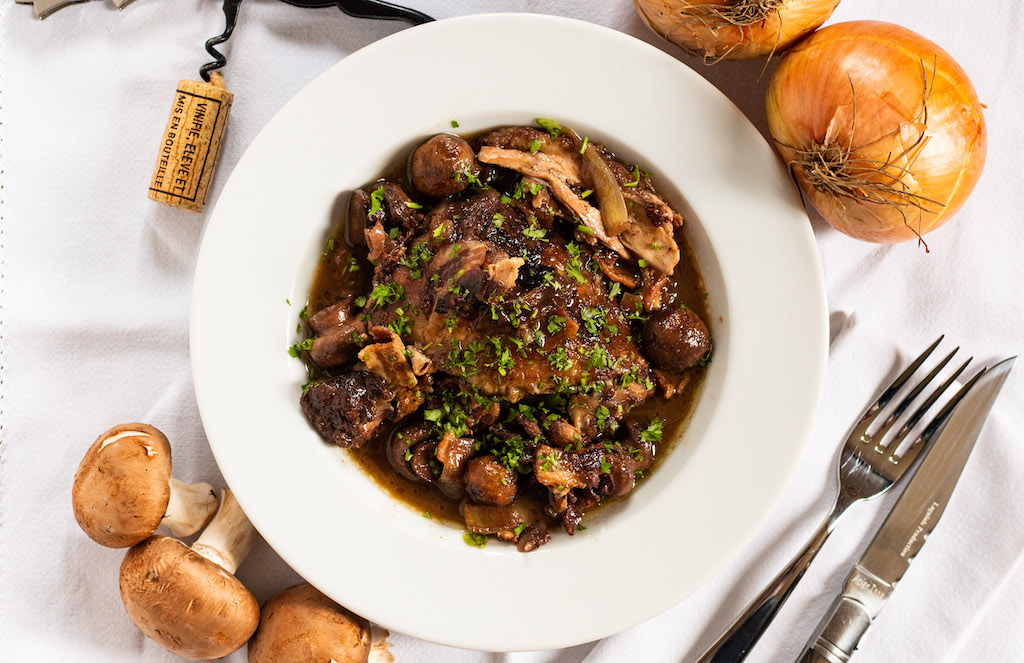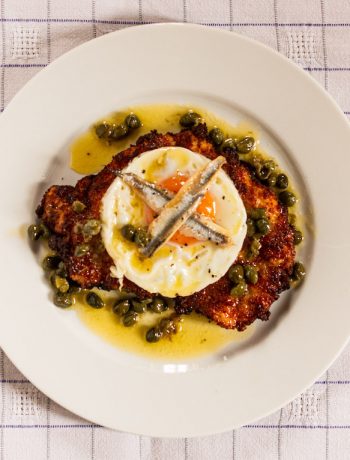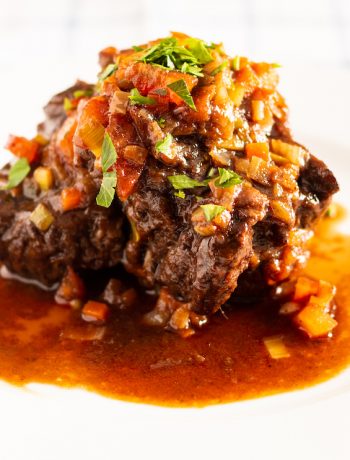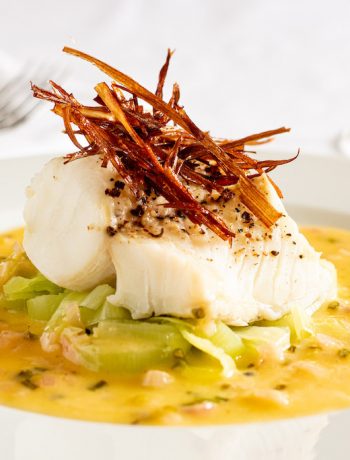Coq au vin is probably a very, very old dish. ‘Coq au vin’ translates to ‘rooster in wine,’ which belies its origins as a peasant dish in which the toughest, old male birds were braised in the local rough wine (which was probably cheaper than clean water). The immovable ingredients may be simply the wine and the bird. The wine is usually red, but coq au vin in an Alsace kitchen is often cooked in Riesling.
The method of cooking coq au vin is very similar to other French stews like boeuf Bourguignon. Meat and vegetables are gilded in fat, and braised in wine for a long time with some kind of thickener added at some point in the process. Finding the origin of it is daft – this will have been done since Roman times – but there is a ‘Recipe Zero.’ This is in a book called Cookery for English Households as ‘poulet au vin blanc.’ The book was written in 1864, and I am not sure if it is the same book as Common-sense Cookery for English Households by A Kenney-Herbert, because I have flicked through a PDF of that, and can’t find poulet au vin blanc in there anywhere. Anyway, like a lot of French dishes, coq au vin went globally viral because of the American chef author Julia Child. Cooking in the 1970s, Child was able to get hold of tough, old roosters, and cooked them for an age. In 2017 Britain, it is not that easy to get hold of rooster (unless I wring the bloody neck of the one in the field opposite my house who brings his henbitches into our garden to dig), so we have to alter the dish a little to deal with the more tender, young hens.
The Guardian’s Felicity Cloake has done the forensics on modern coq au vin, but her article fails to acknowledge that the bird that Child had in her kitchen was not the same beast as the one in the kitchen of the other chefs she researched. Nevertheless, her recipe (as usual) is an excellent distillation of what has to be in the dish, and what looks like it’s landed from Mars.
In the Nosey kitchen, which usually needs to produce food quickly in the evening, we cut a massive corner on coq au vin. We use the Cloake recipe, but instead of splitting the meat from the shallots et al, we produce a wine stock, gild the bacon, chicken, shallots and mushrooms, deglaze, flambée, and then pour the hot, reduced wine over the whole lot in a Tower Automatic Slo Cooker – leaving it to cook for a day.
I appreciate that not everyone lives in 1978 and has a slow cooker (but just go and buy one, OK?), so the recipe below is that of Felicity Cloake with notes on how to adapt it to the Nosey Chef slow version.
Coq au vin
Ingredients
- 1 bottle pinot noir (e.g. red Burgundy)
- 1 carrot, roughly chopped
- 1 celery stalk, roughly chopped
- 1 onion, quartered
- 4 cloves of garlic, lightly crushed with the flat of a knife and chopped, plus 1 minced
- 1 bay leaf
- Small bunch of thyme
- 20g butter
- 150g piece of unsliced streaky bacon, cut into thick chunks; cut a small amount of this into much smaller pieces – you are going to use this for the garnish.
- 8 tbsp plain flour
- 4 chicken legs
- 10 shallots, blanched and peeled
- 200g button mushrooms
- 4 tbsp cognac
- Sea salt and freshly ground black pepper
Instructions
Pour the wine into a saucepan and add the carrot, celery, onion, minced garlic, bay leaf and 4 sprigs of thyme. Bring to the boil and reduce by half. Strain to reserve the wine and discard the flavourings.
Heat the butter over a medium-high heat in a large Dutch oven (e.g. Le Creuset cast iron casserole) and add all the bacon. Cook until golden, then lift out with a slotted spoon and put aside. Meanwhile, tip the flour into a large bowl and season well. Toss the chicken legs in the flour to coat.
Put the chicken in the pan, in batches if necessary, brown well on all sides, lift out, and reserve with the bacon. The bacon may have given off enough fat for the next stage, but if not, add another knob of butter or a slug of oil. Using oil will stop the butter from burning.
Turn the heat down to medium-low and add the shallots. Cook for about 10 minutes, turning occasionally, until slightly caramelised. Add the mushrooms and the chopped garlic, and cook for a further 4 minutes. Lift out and set aside.
Turn up the heat. Deglaze the pan with a ladle of the reduced wine and scrape the bits off the bottom with a wooden spoon. Add the chicken and bacon, but keep the smaller bits bits of the bacon back for the garnish. Pour over the brandy and set alight. When the flames have extinguished, add the rest of the reduced wine. Add some more picked thyme leaves if you like.
At this point, for the none slow method, bring to the boil, turn down the heat, cover and simmer gently for an hour. For the slow method put all of the ingredients and the wine in a slow cooker and set to auto.
Going back to the non-slow version, after an hour, add the onions, mushrooms and garlic and simmer for another 20 minutes, keeping the lid only half on this time. Taste for seasoning and serve.
For the slow version, once cooked, remove all the meat and vegetables to a serving dish in a just-warm oven to keep warm. Transfer the cooking liquor to a pan and boil a little until reduced and tasty. Season, and pour over the meat and veg to serve.
For both methods, garnish with the smaller bacon bits and some fresh, chopped parsley.
Notes
This dish is excellent with mashed potato and a green vegetable side (e.g. steamed French beans).






No Comments